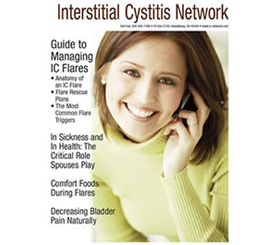When you struggle with IC and/or chronic pain and don’t have access to traditional pain relievers, using an OTC pain relief pill may feel like your only option. Right? I, like most patients, turned to Advil and Tylenol to help reduce my bladder pain when I was first diagnosed. Seriously, IC can hurt terribly and if it’s the middle of the night, it’s fairly natural to turn to that easy bottle sitting on the bathroom shelf. But, here’s the problem. These OTC pain products have some risks, especially when used over the long term.
Acetaminophen (aka Tylenol) is well known for its liver damaging effects when used in high quantities. Harvard’s Family Health Guide wrote “Four thousand milligrams (mg) a day — about 12 regular-strength acetaminophen tablets — is considered the safe upper limit, but that might be too much for some people. Large doses are the main risk, but there are reports of people developing liver problems after taking small to moderate amounts of acetaminophen for long periods of time.”
I was particularly fond of using NSAID’s (i.e. Advil, Motrin, Aleve) which I started using when I was playing the Jr. Tennis circuit. Honestly, I think I took one or two a day for a decade or two to first reduce muscle pain and, later bladder pain, having no clue of the risks that they posed. Yes, I was young and stupid. Reality hit when the medication finally blew my stomach up in my 30’s. I haven’t taken one since. NSAID’s are notorious for their stomach irritating effects.
If you’re in your 20’s, you probably don’t remember the Vioxx scandal. Developed in the 1990’s, Vioxx was a new generation of NSAID pain relievers known as a Cox-2 inhibitors. Designed to be more stomach and gut friendly than traditional NSAID’s, it turned out that they weren’t particularly heart healthy and presented a significant risk of heart attack and stroke. Vioxx was pulled from the market by Merck & Co in 2004.
If you look closely at the labels for NSAID’s today you will see warnings about long term use but new research has shown that short term use is also risky. This month, the FDA issued new safety warnings stating “Serious side effects can occur as early as the first few weeks of using an NSAID, and the risk might rise the longer people take NSAIDs.” (Read the FDA statement here)
Those at the greatest risk for life threatening adverse events are patients who have had a heart attack or bypass surgery. A history of high blood pressure or heart disease are also of concern and these patients should always talk with their medical care provider before using an NSAID to make sure that it’s appropriate for you.
Unfortunately, many OTC medications (i.e. cough syrups, cold and headache medications, etc.) contain NSAID’s and patients may be exposed to more than they realize. Karen Mahoney MD, Deputy Director of the FDA’s Division of Nonprescription Drug Products said “Be careful not to take more than one product that contains an NSAID at a time.”
So what should we do?
 When fighting IC and/or pelvic pain, it’s important to try to determine what the source of the pain is. For us, it’s usually either the bladder wall or the pelvic floor. If it’s from a tight, spasming pelvic floor, then using a muscle relaxant as well as other self-help strategies to reduce muscle tension and relax muscles may help. If it’s a typical flare from eating the wrong food (i.e. coffee or soda), then drinking water to dilute the urine along with an alkalinizing agent (i.e. Prelief) to reduce acid in urine is usually where patients start. AZO Bladder Pain Relief tablets can help ease bladder wall pain by numbing the bladder wall. ProSirona or Neuroquell are essential oils that have been proven in research studies to reduce some types of pelvic pain and are also worth a try!
When fighting IC and/or pelvic pain, it’s important to try to determine what the source of the pain is. For us, it’s usually either the bladder wall or the pelvic floor. If it’s from a tight, spasming pelvic floor, then using a muscle relaxant as well as other self-help strategies to reduce muscle tension and relax muscles may help. If it’s a typical flare from eating the wrong food (i.e. coffee or soda), then drinking water to dilute the urine along with an alkalinizing agent (i.e. Prelief) to reduce acid in urine is usually where patients start. AZO Bladder Pain Relief tablets can help ease bladder wall pain by numbing the bladder wall. ProSirona or Neuroquell are essential oils that have been proven in research studies to reduce some types of pelvic pain and are also worth a try!
And, if the pain does not improve and/or gets worse, a call to your medical care provider is essential. Many patients, myself included, have required stronger pain medication, such as narcotic medication. And, if you review the AUA’s Treatment Guidelines for IC (Released in 2011 and revised in 2014), they strongly suggest that patients be evaluated for pain at every doctors appointment and that pain should be treated aggressively and with multimodal therapies.
“The goal of pharmacotherapy is to find medication/medications that provide significant pain relief with minimal side effects. Pain management tools include urinary analgesics, NSAIDs, narcotics, and a wide variety of nonnarcotic medications used for chronic pain which have been “borrowed” from the treatment of depression, epilepsy, arrhythmias, etc. The use of narcotics presents the risks of tolerance and dependence (although very rarely addiction) but it is clear that many patients benefit from narcotic analgesia as part of a comprehensive program to manage pain.” (AUA Guideline Statement 14 Discussion)
Learn more about IC flares and pelvic pain in our free 40 page Guide to Managing IC Flares, which you can receive by signing up for our e-newsletter!
Update – July 15, 2015
Researchers in Korea released a new study yesterday which found that the combination of antidepressants and NSAIDS have been linked to an early increased risk of intracranial hemorrhage during the first thirty days of treatment REGARDLESS of the type of NSAID used. Men were found to have the strongest risk factor though age was not. This raises significant concerns given that 65% of adults with depression also struggle with chronic pain, the authors noted. They encourage physicians, particularly psychiatrists who might be subscribing antidepressants, to ask about the presence of chronic pain and use of NSAID’s. Source: Antidepressant/NSAID Combo Linked to Brain Bleed Risk

